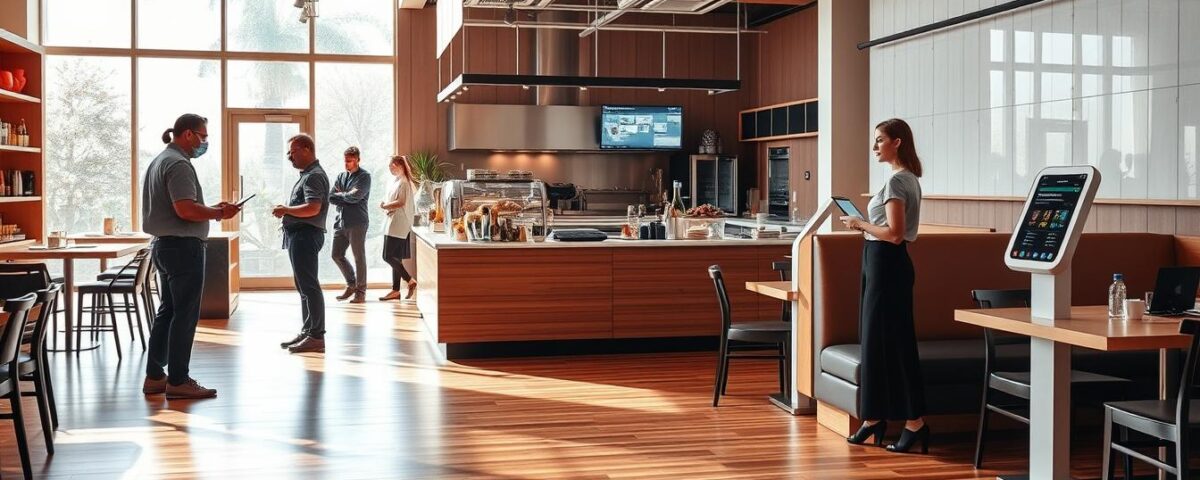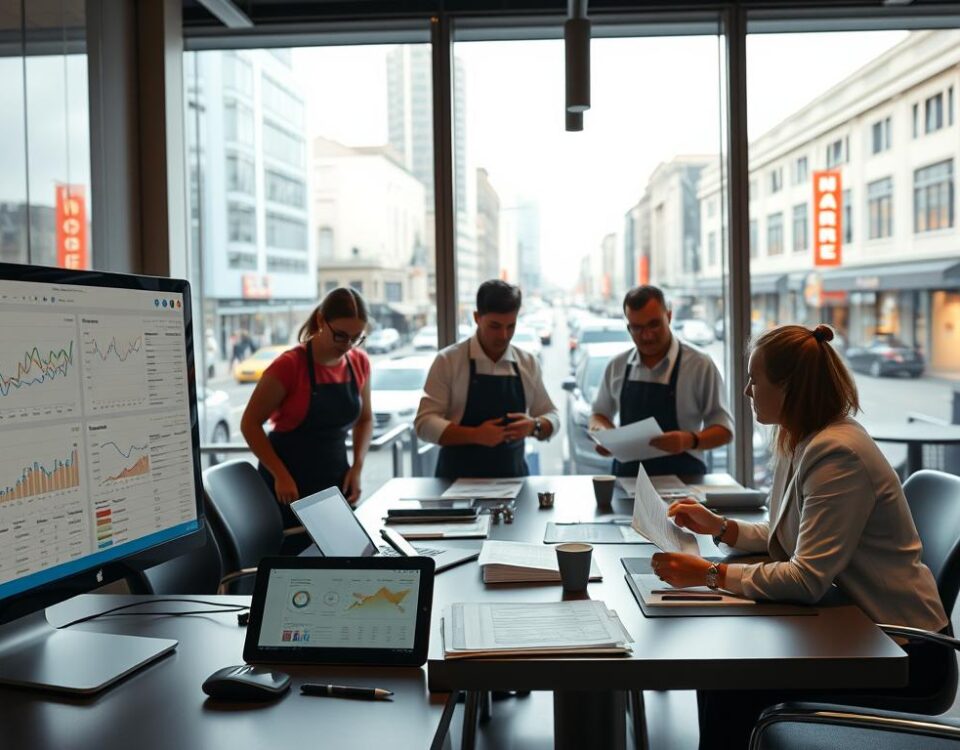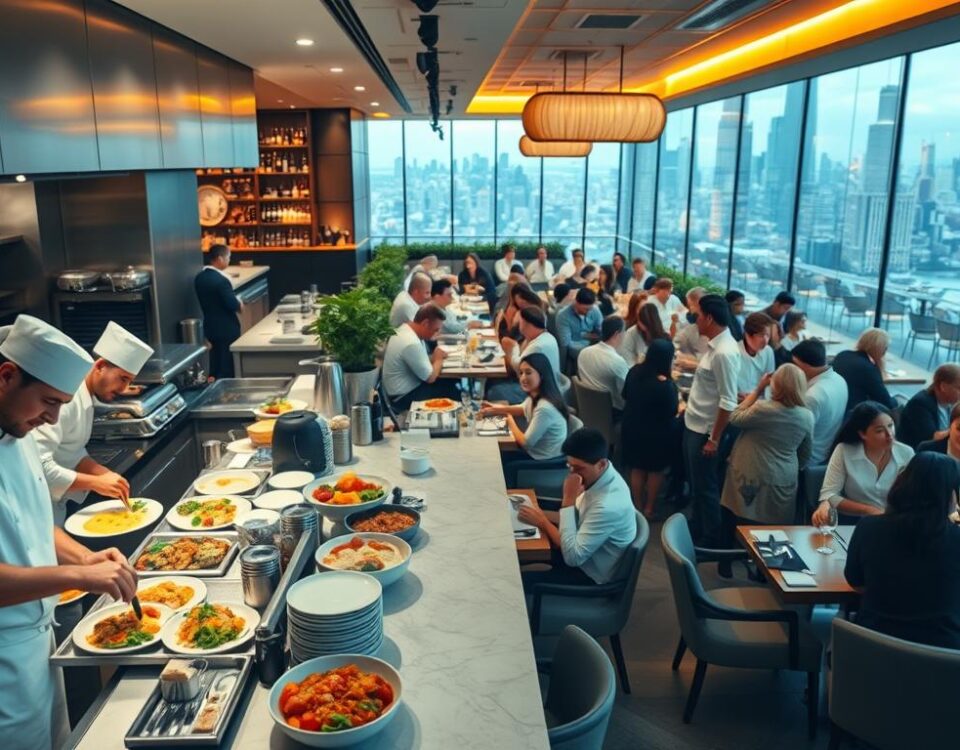
How to Launch a Profitable Ghost Kitchen in 30 Days
October 10, 2025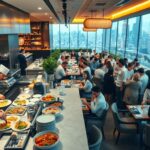
Restaurant Industry Trends 2025: 8 Shifts to Watch
October 11, 2025Running a restaurant is a labor of love, but it’s no secret that the industry is fraught with challenges. As a restaurant owner, you’re constantly juggling quality service, financial sustainability, and customer satisfaction. Did you know that according to recent statistics, nearly 60% of restaurants fail within the first year due to poor management and inefficient operations?
This guide is designed to help you navigate these challenges and transform your business for maximum profit. By implementing the right strategies, you can significantly boost your bottom line and ensure long-term success in today’s competitive market.
So, how can you modernize your operations to stay ahead of the curve and achieve the profit you deserve?
Key Takeaways
- Comprehensive strategies to transform restaurant operations and maximize profitability.
- Proven methods for modernizing every aspect of your business, from operations to customer experience.
- Practical tips on implementing the right technology and optimizing your menu.
- Techniques for enhancing customer interactions to boost your bottom line.
- A focus on sustainable growth rather than quick fixes for long-term success.
Understanding Restaurant Profit Margins
Profit margins vary significantly across different types of restaurants, affecting their modernization strategies. As a restaurant owner, understanding these margins is crucial for making informed decisions that can drive your business forward.
Calculating Gross and Net Profit Margins
To understand your restaurant’s financial health, you need to calculate both gross and net profit margins. Gross profit margin is the difference between revenue and the cost of goods sold (COGS), divided by revenue. Net profit margin, on the other hand, takes into account all expenses, including labor, rent, and marketing, providing a comprehensive view of your restaurant’s profitability.
- Gross Profit Margin = (Revenue – COGS) / Revenue
- Net Profit Margin = (Total Revenue – Total Expenses) / Total Revenue
Average Profit Margins by Restaurant Type
Different types of restaurants have varying profit margins due to their distinct operational models. Full-service restaurants, known for their extensive menus and elegant settings, typically see profit margins between 3% to 5%. In contrast, quick-service restaurants (QSRs) often enjoy higher margins, ranging from 6% to 9%, due to their streamlined operations and lower labor costs.
Understanding these industry averages helps you benchmark your restaurant’s performance and identify areas for improvement within the industry. By focusing on your specific restaurant type and leveraging its strengths, you can implement modernization strategies that enhance your food offerings and overall customer experience.
Assessing Your Restaurant’s Current State
Understanding your restaurant’s strengths and weaknesses is the first step towards modernization and increased profitability. In this new digital era of hospitality, your guests expect more from each restaurant experience.
Identifying Operational Inefficiencies
To identify operational inefficiencies, you need to examine your current systems and processes. Look for signs of outdated technology, such as manual ordering systems or inefficient inventory management. These inefficiencies can lead to wasted time, resources, and revenue.
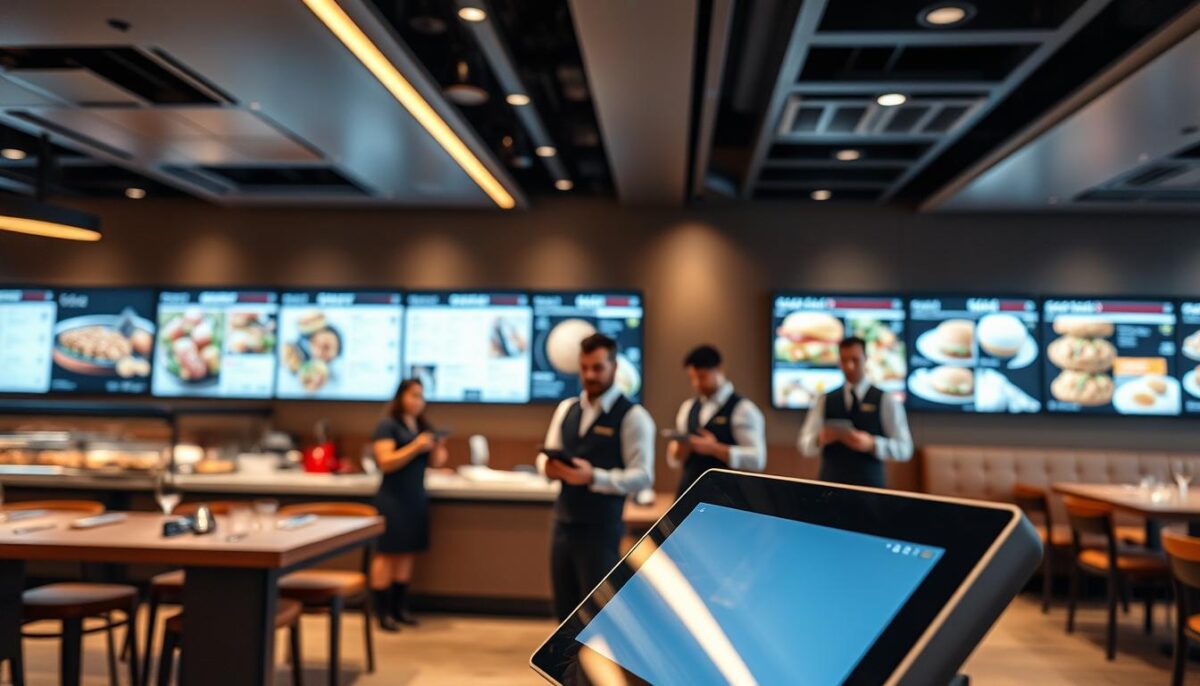
- Inefficient labor scheduling
- Manual data entry
- Lack of real-time inventory tracking
Recognizing Opportunities for Modernization
Recognizing opportunities for modernization requires a thorough understanding of your restaurant’s operations and customer needs. By leveraging technology, you can streamline operations, enhance customer experience, and increase revenue.
| Modernization Opportunity | Potential Benefits |
|---|---|
| Implementing a POS system | Streamlined operations, improved accuracy |
| Inventory management software | Reduced waste, optimized inventory levels |
| Digital menu boards | Enhanced customer experience, reduced labor costs |
By assessing your restaurant’s current state and identifying opportunities for modernization, you can create a roadmap for success and stay ahead in the competitive hospitality industry.
Implementing Restaurant Management Systems
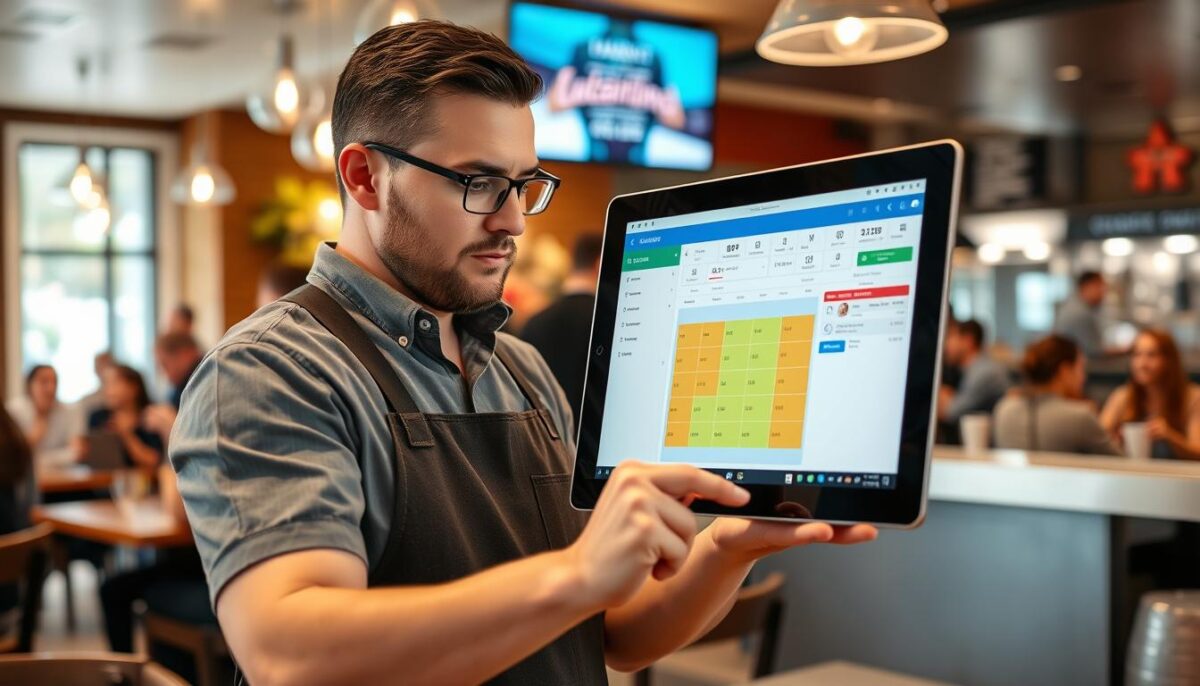
To stay competitive, restaurants are turning to advanced management systems that streamline operations and boost profitability. Effective restaurant management software is crucial for optimizing daily tasks, reducing costs, and enhancing customer satisfaction.
POS Systems for Streamlined Operations
A Point of Sale (POS) system is more than just a tool for processing transactions; it’s the nerve center of your restaurant’s operations. Modern POS systems offer a range of features that can significantly improve efficiency, including order management, inventory tracking, and customer relationship management. By automating many tasks, a POS system allows your staff to focus on providing excellent customer service.
With a robust POS system, you can streamline your service, reduce wait times, and improve overall customer satisfaction. It’s an essential tool for any restaurant aiming to stay competitive in today’s fast-paced dining industry.
Inventory Management Software to Reduce Waste
Inventory management software acts as a sous-chef in your restaurant’s kitchen, continuously monitoring food and beverage stock. By delivering real-time data and automating inventory processes, this technology can significantly reduce waste and optimize your purchasing strategy. Automated alerts for low stock levels ensure that you’re always prepared, allowing for precise restocking and minimizing the risk of running out of popular ingredients.
- Modern inventory management software transforms your restaurant’s approach to food purchasing, storage, and usage.
- Automated inventory tracking helps reduce food waste, one of the biggest profit drains in the restaurant industry.
- Real-time inventory data enables more accurate ordering, reducing both stockouts and excess inventory.
- Inventory software helps identify theft, waste, and inefficient food usage patterns through detailed analytics.
- Implementing inventory systems that integrate with your POS and accounting software ensures seamless operations.
- Using inventory data to optimize your menu offerings and pricing can significantly impact your profit margins.
- Training kitchen staff to use inventory management tools effectively is crucial for daily workflow.
How to Modernize Your Restaurant for Profit Through Menu Engineering
Effective menu engineering is the pathway to modernizing your restaurant for maximum profit. By strategically designing your menu and implementing pricing strategies, you can significantly enhance your restaurant’s profitability.
Strategic Menu Design and Layout
A well-designed menu is crucial for driving sales and increasing profit margins. To achieve this, consider the layout and visual appeal of your menu. Use clear typography and high-quality images to showcase your dishes. Organize your menu into sections that guide the customer’s eye towards high-profit items.
Key considerations for menu design include:
- Highlighting signature dishes
- Using pricing strategies to influence customer choices
- Incorporating seasonal items to keep the menu fresh
| Menu Design Element | Purpose | Example |
|---|---|---|
| Clear Typography | Easy to read | Using fonts like Arial or Helvetica |
| High-Quality Images | Showcases dishes attractively | Professional food photography |
| Sectioning | Guides customer’s eye | Separating appetizers from main courses |
Pricing Strategies for Higher Margins
Pricing strategies are the seasoning that can enhance the flavors of profitability. By adjusting portion sizes, ingredients, or even the price of popular but low-profit items, you can subtly improve margins without alienating your clientele.
Some effective pricing strategies include:
- Psychological pricing techniques, such as charm pricing and prestige pricing
- Conducting a thorough cost analysis of each menu item
- Creating price anchors and decoys to make target items more attractive
- Introducing premium ingredients and upcharges
- Adjusting portion sizes strategically to control food costs
By implementing these strategies, you can drive sales while testing price elasticity, ultimately enhancing your restaurant’s profit margins.
Reducing Operational Costs
Operational costs can silently erode your restaurant’s profits, making it essential to identify areas for reduction. By focusing on key areas such as food waste, labor costs, and energy consumption, you can significantly lower your operational expenses.
Food Waste Reduction Techniques
Reducing food waste is a critical step in minimizing operational costs. Implementing inventory management software can help track and manage your stock more efficiently, reducing the likelihood of overordering and waste. Additionally, training your staff on proper food handling and storage techniques can further minimize waste.
- Conduct regular inventory audits to identify areas of waste.
- Implement portion control to reduce excess food preparation.
- Use data analytics to predict demand and adjust orders accordingly.
Labor Cost Optimization
Optimizing labor costs involves analyzing your staff’s productivity and scheduling. By using labor forecasting tools, you can ensure that you’re not overstaffing during slow periods, thus saving on unnecessary labor costs. Cross-training staff to handle multiple roles can also enhance efficiency.
- Analyze sales data to predict busy periods and adjust staffing accordingly.
- Implement flexible scheduling to match staff levels with customer demand.
- Train staff on multiple tasks to improve overall efficiency.
Energy-Efficient Solutions
Utility bills are a controllable expense that can significantly impact your restaurant’s profit margin. Switching to energy-efficient appliances and automating your temperature controls and lighting systems can lower these costs. Conducting an energy audit can help identify areas for improvement.
- Invest in modern kitchen equipment that uses less energy.
- Implement smart thermostats and automated lighting systems.
- Train staff on energy conservation practices to further reduce costs.
By implementing these strategies, you can significantly reduce your restaurant’s operational costs, contributing to a healthier profit margin. It’s about being mindful of every expense and continually looking for ways to optimize your operations.
Enhancing the Customer Experience
In today’s competitive dining landscape, enhancing the customer experience is key to a restaurant’s success. By focusing on creating a welcoming atmosphere and personalizing guest interactions, restaurants can increase customer loyalty and ultimately drive profits.
Creating a Welcoming Atmosphere
A welcoming atmosphere is crucial for making customers feel at home. This can be achieved by paying attention to the ambiance, décor, and overall aesthetic of the restaurant. Comfortable seating, soft lighting, and pleasant background music can all contribute to a positive dining experience. Moreover, ensuring that the staff is friendly and attentive is vital. Training staff to be knowledgeable about the menu and to provide exceptional service can make a significant difference.

Personalizing Guest Interactions
Personalizing guest interactions is another critical aspect of enhancing the customer experience. By collecting and utilizing customer data, restaurants can create tailored experiences that make customers feel valued. This can involve using a customer relationship management (CRM) system to track guest preferences and behaviors. For instance, knowing a customer’s favorite dish or wine can help staff to provide personalized recommendations. Additionally, acknowledging special occasions such as birthdays or anniversaries can make customers feel special and appreciated.
Some effective strategies for personalizing guest interactions include:
- Training staff to recognize and greet returning customers by name
- Using data to offer personalized menu recommendations
- Acknowledging and celebrating special occasions
- Implementing loyalty programs that reward repeat customers
By implementing these strategies, restaurants can create a loyal customer base and drive long-term success.
Leveraging Technology for Better Guest Data
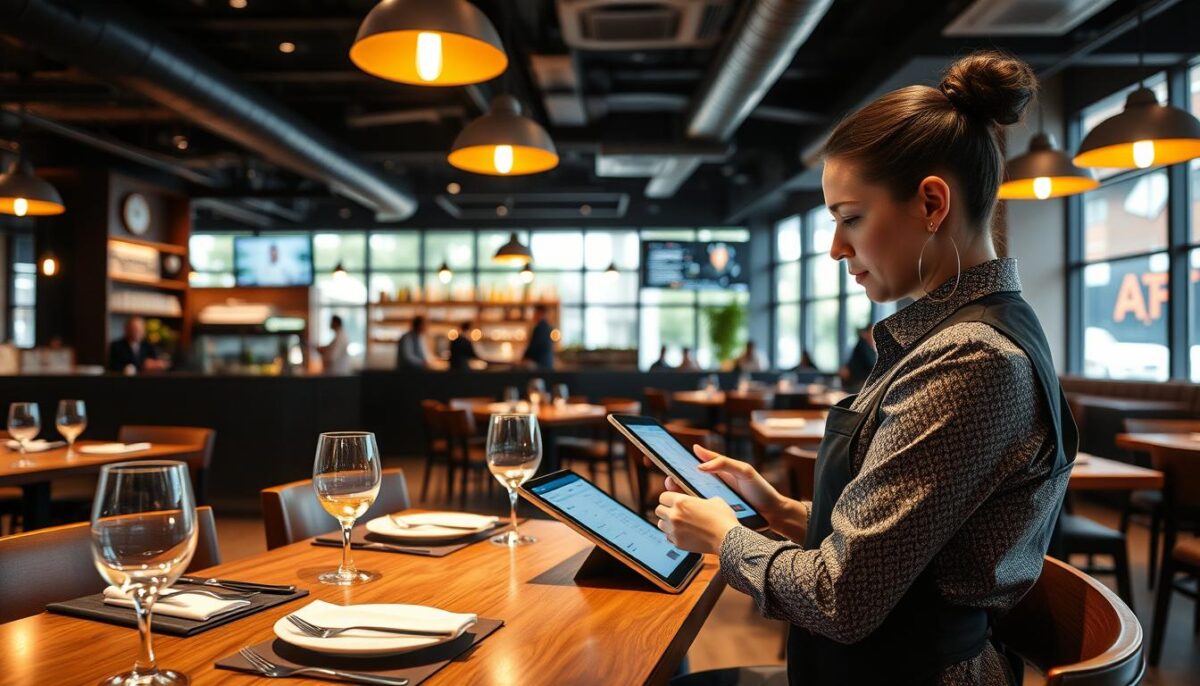
The key to unlocking a more personalized and profitable restaurant service lies in effectively harnessing guest data through modern technology. By leveraging advanced systems like Guest Experience Management (GXM) platforms, restaurants can gather valuable insights into customer preferences and behaviors.
Building Customer Profiles
Building comprehensive customer profiles is a crucial step in utilizing guest data effectively. With a platform like Superb’s GXM, you can register guest data and create detailed profiles. As Roy Magne Berglund, Owner of Lofoten Food Studio in Norway, notes, “Having an all-in-one platform simplifies my daily operations and gathers all my guest data in one place.”
This streamlined approach enables your team to make each guest feel special, fostering loyalty and encouraging repeat business. By integrating data from various touchpoints, you can develop a nuanced understanding of your customers’ preferences.
Using Data to Create Personalized Experiences
Transforming raw customer data into actionable insights is essential for enhancing the dining experience. By analyzing customer history, you can anticipate needs and preferences before guests even place their orders. Implementing personalized recommendations and special offers based on individual guest profiles can significantly boost customer satisfaction and drive sales.
Predictive analytics can help forecast customer behavior, allowing you to tailor your service approach accordingly. Training your staff to use customer data effectively without making interactions feel scripted is crucial. By measuring the impact of personalization efforts, you can refine your approach and justify technology investments.
Creating memorable, personalized moments can transform occasional diners into loyal advocates for your restaurant. By leveraging technology to gather and utilize guest data, you can elevate the customer experience, drive repeat business, and ultimately increase sales.
Modernizing Your Restaurant’s Online Presence
Modernizing your restaurant’s online presence is key to attracting and retaining customers. In today’s digital landscape, a strong online presence is crucial for the success of your restaurant.
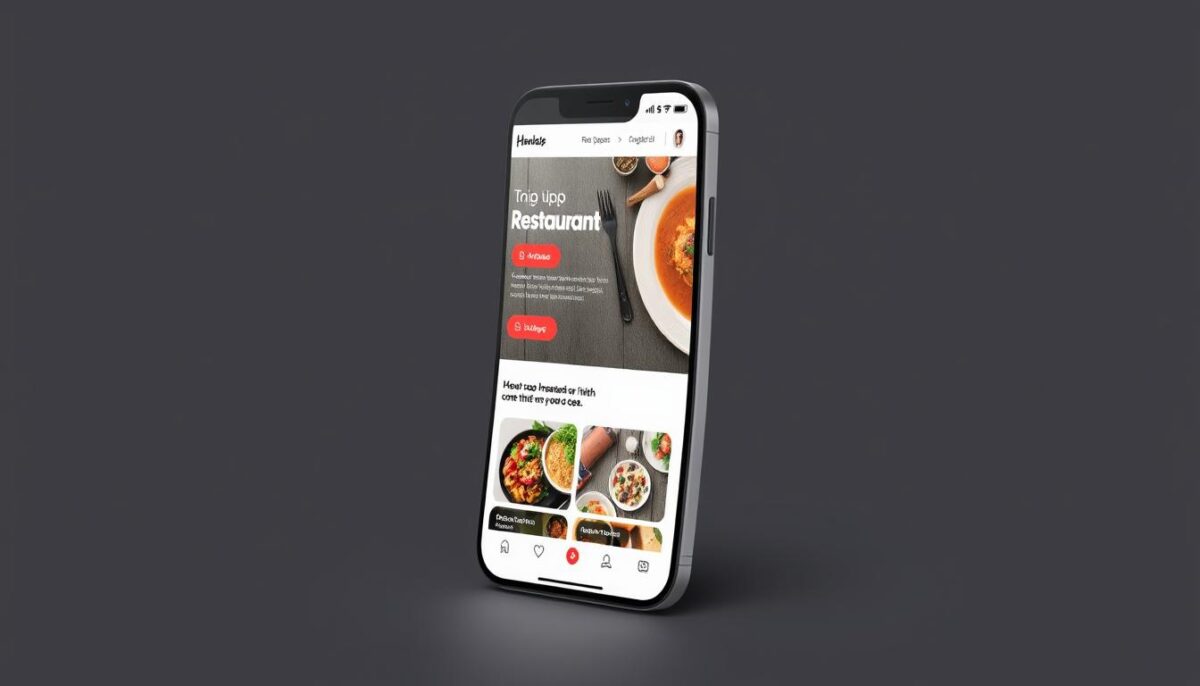
Website Optimization for Mobile Users
With most customers using their mobile devices to search for restaurants, having a mobile-friendly website is no longer optional. Your restaurant’s website should be responsive, meaning it adapts to different screen sizes and devices. This ensures that potential customers can easily navigate your site, view your menu, and make reservations or order online.
To optimize your website for mobile users, focus on page loading speed, simple navigation, and clear calls-to-action. Ensure that your website’s design is clean and that the content is easily readable on smaller screens.
Social Media Marketing Strategies
Social media is a powerful tool for engaging with your customers and promoting your restaurant. Platforms like Facebook, Instagram, and TikTok allow you to share your story, showcase your dishes, and interact with your audience. To develop a cohesive social media strategy, start by identifying your target audience and the platforms they use most.
Focus on creating compelling visual content that highlights your restaurant’s unique atmosphere and cuisine. Use a content calendar to balance promotional posts with engaging content that encourages interaction. Respond promptly to reviews and comments to build your reputation and show your commitment to customer satisfaction.
Implementing Effective Loyalty Programs
To maximize customer loyalty and retention, it’s essential to implement a robust loyalty program tailored to your restaurant’s needs. Customer loyalty programs demonstrate that you value your patrons, encouraging repeat business and fostering a loyal customer base.
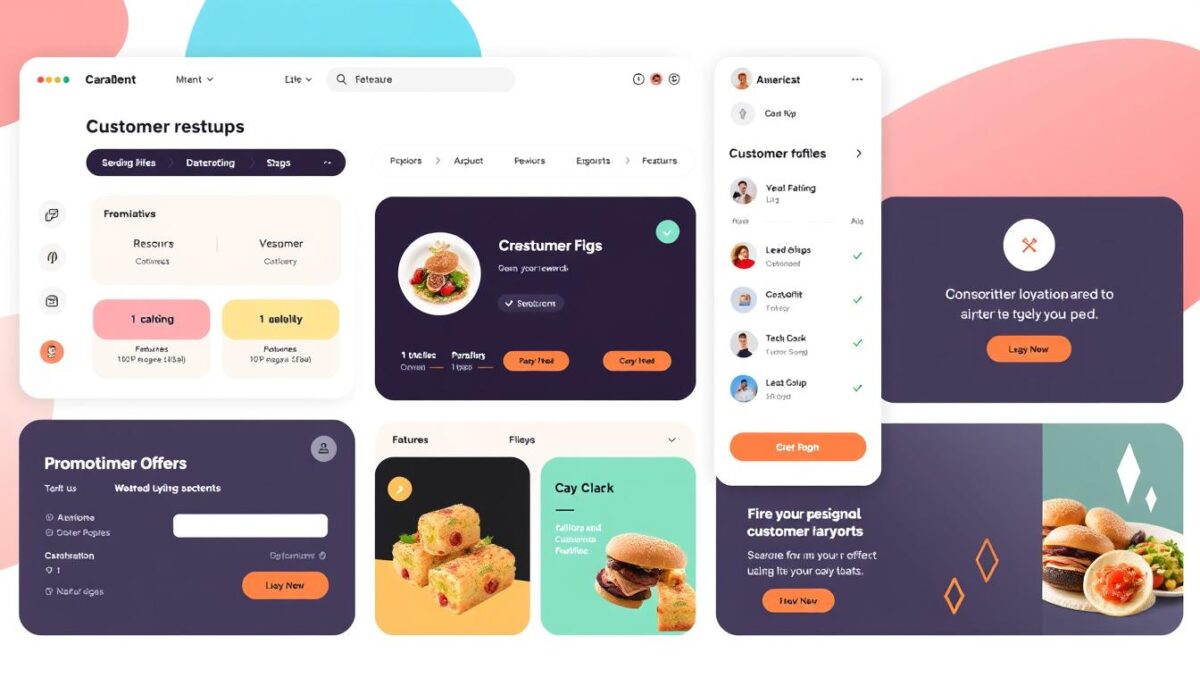
Digital Rewards Systems
A digital rewards system is a crucial component of a modern loyalty program. It allows customers to earn points or rewards for their purchases, which can be redeemed for discounts or free menu items. By leveraging technology, you can create a seamless and engaging experience for your customers.
Digital rewards systems can be integrated with your existing POS system, making it easy to track customer purchases and reward their loyalty. This not only enhances customer satisfaction but also encourages repeat business, driving sales and revenue for your restaurant.
Measuring Loyalty Program Success
To ensure the effectiveness of your loyalty program, it’s crucial to measure its success through key performance indicators (KPIs). I’ll explain how to establish KPIs that accurately measure the impact of your loyalty program on your bottom line. You’ll learn techniques for analyzing customer retention rates, frequency of visits, and average check size among loyalty program members.
By using data to inform your decisions, you can refine your loyalty program offerings and communication strategies for maximum effectiveness. This includes calculating the return on investment (ROI) of your loyalty program, accounting for both direct costs and incremental revenue.
To further optimize your loyalty program, consider using A/B testing to refine your offerings and communication strategies. Gathering and analyzing customer feedback is also essential to ensure your loyalty program truly enhances the customer experience. By understanding which rewards drive the most valuable customer behaviors, you can optimize your program structure over time.
Expanding Revenue Streams
Expanding your restaurant’s revenue streams is crucial for long-term success and profitability. In today’s competitive dining landscape, relying on a single source of income can be risky.
Online Ordering and Delivery Integration
Integrating online ordering and delivery into your restaurant’s operations can significantly boost revenue. By partnering with food delivery services or developing your own online ordering system, you can tap into the growing demand for convenience and reach a wider customer base.
To maximize the benefits, ensure that your online ordering system is user-friendly and seamlessly integrated with your POS system. Consider offering exclusive promotions or discounts to customers who order online to encourage repeat business.
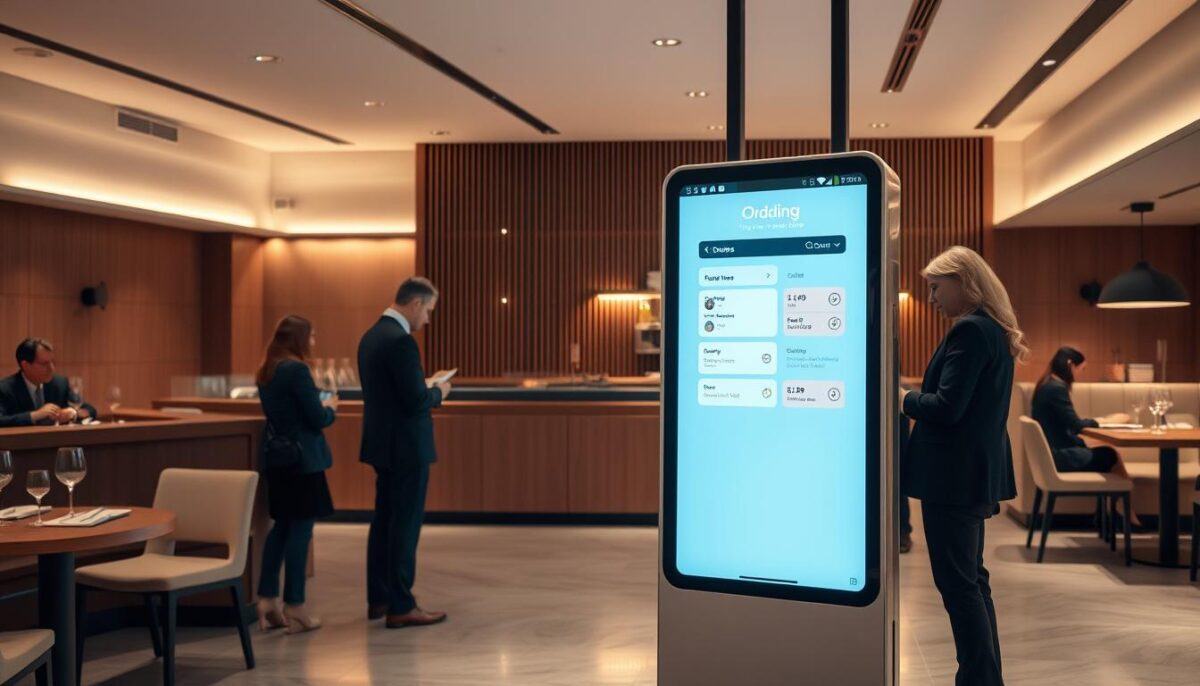
Hosting Special Events and Promotions
Hosting special events and promotions is an effective way to drive sales and attract new customers to your restaurant. By leveraging modern event management tools, you can transform your restaurant into a profitable venue for special occasions.
- Develop signature events that align with your brand and appeal to your target audience.
- Create themed dining experiences, tasting menus, and chef’s tables that command premium pricing.
- Implement ticketed events to generate guaranteed revenue and reduce uncertainty.
- Partner with local businesses and influencers to expand your reach and create mutually beneficial promotions.
By hosting events during traditionally slow periods, you can significantly improve your overall revenue management. Additionally, leveraging special events for content creation and publicity can help build your brand beyond the event itself, enhancing your marketing efforts and ultimately increasing profit.
Conclusion: Your Roadmap to a Profitable Modern Restaurant
Modernizing your restaurant for maximum profit requires a comprehensive approach. By implementing the strategies outlined in this guide, you can significantly enhance your restaurant’s profitability.
To recap, we’ve covered key areas such as assessing your current state, implementing restaurant management systems, and leveraging technology for better guest data. These steps work together to create a cohesive plan for modernizing your restaurant.
To get started, prioritize strategies based on potential impact and resource requirements. Create a phased modernization plan that allows for sustainable change without overwhelming your team or budget. Monitor key performance indicators to track financial and operational improvements.
By embracing modernization and staying ahead of industry trends, you can ensure your restaurant remains competitive and profitable. Begin your journey today and take the first step towards a more successful business.
FAQ
How can I improve my restaurant’s profit margins?
To boost profit margins, I focus on optimizing menu engineering, reducing operational costs, and leveraging technology to streamline operations and enhance customer experience.
What is the best way to assess my restaurant’s current state?
I evaluate my restaurant’s operational inefficiencies, identify areas for modernization, and analyze customer feedback to determine the most effective improvements.
How can I reduce food waste in my restaurant?
I implement inventory management software to track and manage inventory levels, and adopt food waste reduction techniques, such as using every part of the ingredient and creative menu planning.
What are the benefits of implementing a POS system in my restaurant?
A POS system helps me streamline operations, manage sales, and track customer data, enabling me to make informed decisions and improve overall efficiency.
How can I create a welcoming atmosphere in my restaurant?
I focus on creating a warm and inviting ambiance by optimizing lighting, décor, and music, and training my staff to provide exceptional customer service.
What are the advantages of digital loyalty programs?
Digital loyalty programs allow me to track customer behavior, offer personalized rewards, and measure program success, ultimately driving customer retention and increased revenue.
How can I effectively market my restaurant on social media?
I develop a social media marketing strategy that includes engaging content, targeted advertising, and customer interaction to build brand awareness and attract new customers.
What are the benefits of online ordering and delivery integration?
Online ordering and delivery integration enable me to expand my revenue streams, increase customer convenience, and improve overall customer satisfaction.
How can I measure the success of my loyalty program?
I track key metrics, such as customer retention rates, redemption rates, and overall revenue growth, to evaluate the effectiveness of my loyalty program and make data-driven decisions.
